A Comprehensive Assessment of Customer Satisfaction at KDU Cafeteria
VerifiedAdded on 2021/09/17
|47
|13711
|528
Report
AI Summary
This report presents an assessment of customer satisfaction at the KDU cafeteria, focusing on the correlation between food quality, price, service, and ambiance, and the overall satisfaction levels of students. The research involved a survey of 152 respondents, both online and offline, to gather data on their dining experiences. The study investigates the influence of these factors on student choices and satisfaction, including the impact of monthly income on price satisfaction. A literature review provides context, and the data analysis, using SPSS and correlation analysis, reveals key findings. The report concludes with recommendations for improving customer satisfaction, offering valuable insights for KDU cafeteria management to enhance its services, attract more students, and increase sales. The study highlights the importance of food quality, reasonable prices, and a satisfactory environment for student satisfaction.
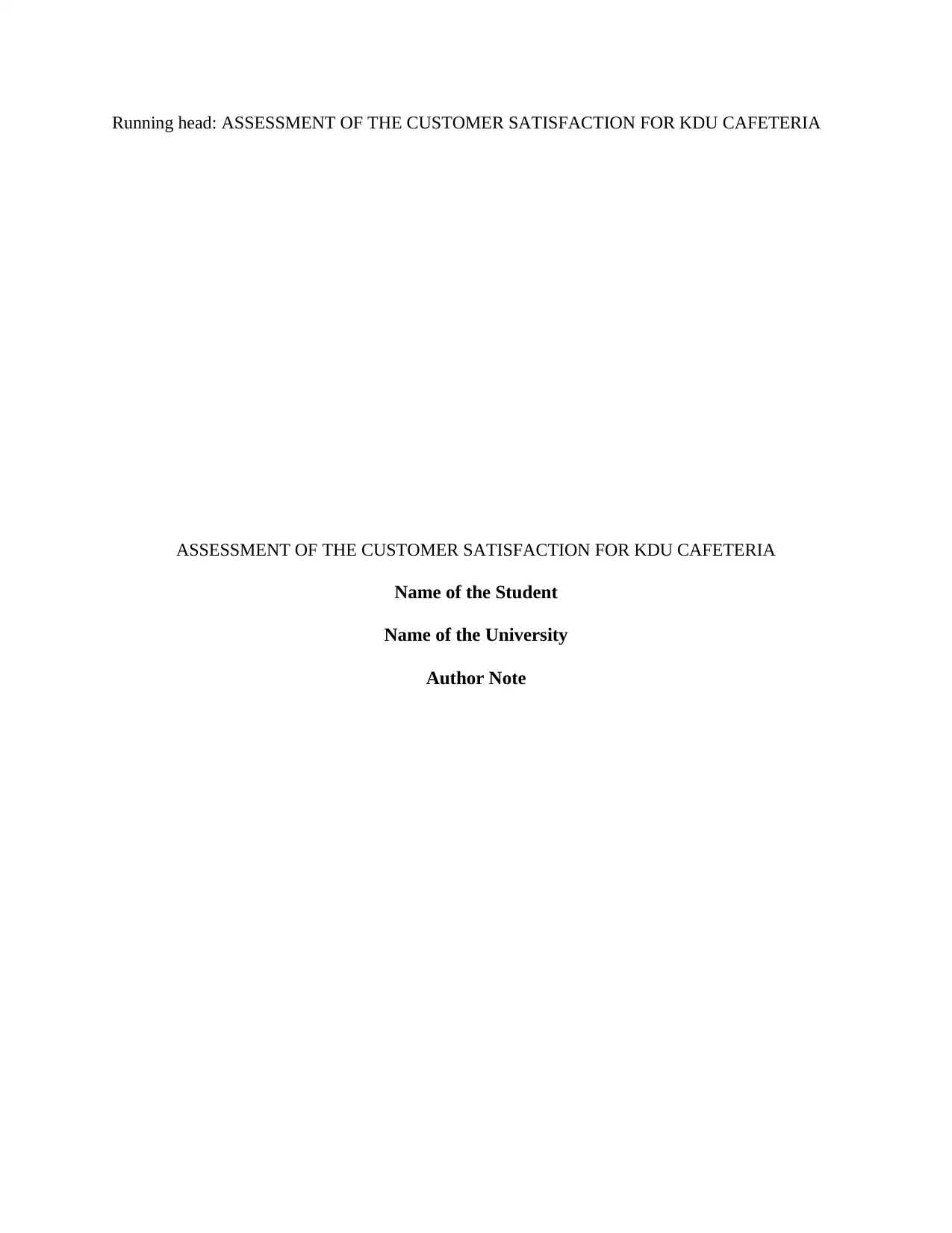
Running head: ASSESSMENT OF THE CUSTOMER SATISFACTION FOR KDU CAFETERIA
ASSESSMENT OF THE CUSTOMER SATISFACTION FOR KDU CAFETERIA
Name of the Student
Name of the University
Author Note
ASSESSMENT OF THE CUSTOMER SATISFACTION FOR KDU CAFETERIA
Name of the Student
Name of the University
Author Note
Paraphrase This Document
Need a fresh take? Get an instant paraphrase of this document with our AI Paraphraser
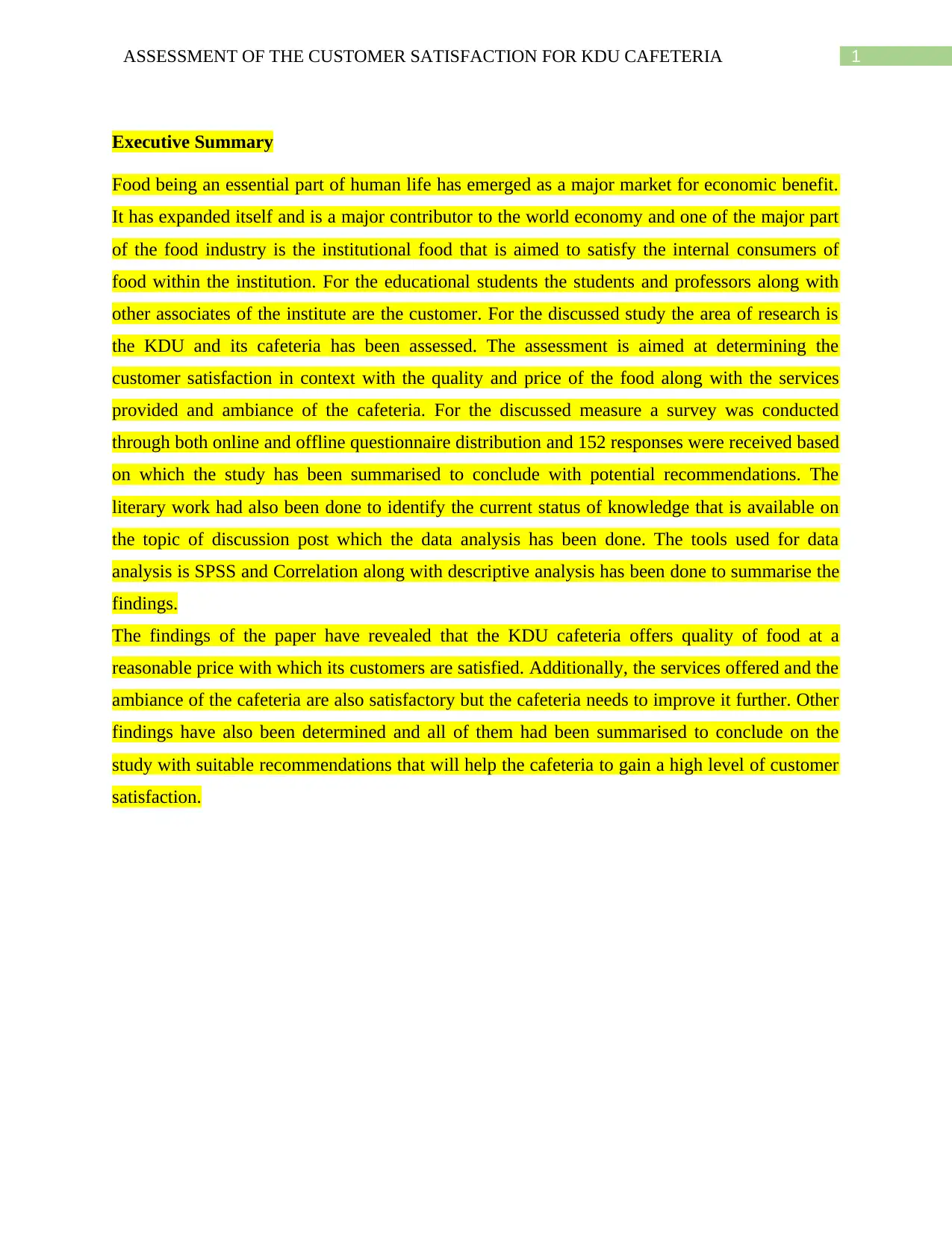
ASSESSMENT OF THE CUSTOMER SATISFACTION FOR KDU CAFETERIA 1
Executive Summary
Food being an essential part of human life has emerged as a major market for economic benefit.
It has expanded itself and is a major contributor to the world economy and one of the major part
of the food industry is the institutional food that is aimed to satisfy the internal consumers of
food within the institution. For the educational students the students and professors along with
other associates of the institute are the customer. For the discussed study the area of research is
the KDU and its cafeteria has been assessed. The assessment is aimed at determining the
customer satisfaction in context with the quality and price of the food along with the services
provided and ambiance of the cafeteria. For the discussed measure a survey was conducted
through both online and offline questionnaire distribution and 152 responses were received based
on which the study has been summarised to conclude with potential recommendations. The
literary work had also been done to identify the current status of knowledge that is available on
the topic of discussion post which the data analysis has been done. The tools used for data
analysis is SPSS and Correlation along with descriptive analysis has been done to summarise the
findings.
The findings of the paper have revealed that the KDU cafeteria offers quality of food at a
reasonable price with which its customers are satisfied. Additionally, the services offered and the
ambiance of the cafeteria are also satisfactory but the cafeteria needs to improve it further. Other
findings have also been determined and all of them had been summarised to conclude on the
study with suitable recommendations that will help the cafeteria to gain a high level of customer
satisfaction.
Executive Summary
Food being an essential part of human life has emerged as a major market for economic benefit.
It has expanded itself and is a major contributor to the world economy and one of the major part
of the food industry is the institutional food that is aimed to satisfy the internal consumers of
food within the institution. For the educational students the students and professors along with
other associates of the institute are the customer. For the discussed study the area of research is
the KDU and its cafeteria has been assessed. The assessment is aimed at determining the
customer satisfaction in context with the quality and price of the food along with the services
provided and ambiance of the cafeteria. For the discussed measure a survey was conducted
through both online and offline questionnaire distribution and 152 responses were received based
on which the study has been summarised to conclude with potential recommendations. The
literary work had also been done to identify the current status of knowledge that is available on
the topic of discussion post which the data analysis has been done. The tools used for data
analysis is SPSS and Correlation along with descriptive analysis has been done to summarise the
findings.
The findings of the paper have revealed that the KDU cafeteria offers quality of food at a
reasonable price with which its customers are satisfied. Additionally, the services offered and the
ambiance of the cafeteria are also satisfactory but the cafeteria needs to improve it further. Other
findings have also been determined and all of them had been summarised to conclude on the
study with suitable recommendations that will help the cafeteria to gain a high level of customer
satisfaction.
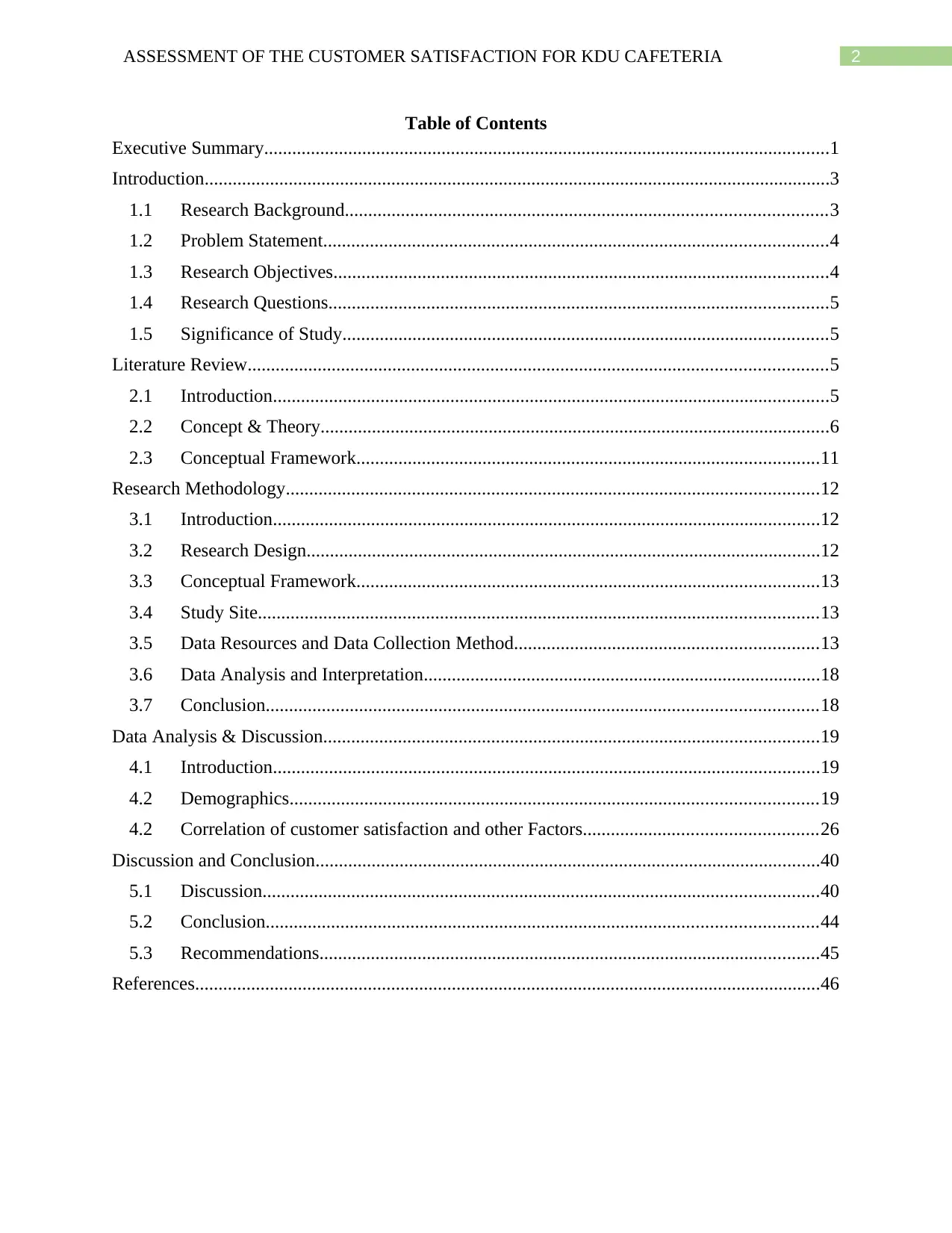
ASSESSMENT OF THE CUSTOMER SATISFACTION FOR KDU CAFETERIA 2
Table of Contents
Executive Summary.........................................................................................................................1
Introduction......................................................................................................................................3
1.1 Research Background.......................................................................................................3
1.2 Problem Statement............................................................................................................4
1.3 Research Objectives..........................................................................................................4
1.4 Research Questions...........................................................................................................5
1.5 Significance of Study........................................................................................................5
Literature Review............................................................................................................................5
2.1 Introduction.......................................................................................................................5
2.2 Concept & Theory.............................................................................................................6
2.3 Conceptual Framework...................................................................................................11
Research Methodology..................................................................................................................12
3.1 Introduction.....................................................................................................................12
3.2 Research Design..............................................................................................................12
3.3 Conceptual Framework...................................................................................................13
3.4 Study Site........................................................................................................................13
3.5 Data Resources and Data Collection Method.................................................................13
3.6 Data Analysis and Interpretation.....................................................................................18
3.7 Conclusion......................................................................................................................18
Data Analysis & Discussion..........................................................................................................19
4.1 Introduction.....................................................................................................................19
4.2 Demographics.................................................................................................................19
4.2 Correlation of customer satisfaction and other Factors..................................................26
Discussion and Conclusion............................................................................................................40
5.1 Discussion.......................................................................................................................40
5.2 Conclusion......................................................................................................................44
5.3 Recommendations...........................................................................................................45
References......................................................................................................................................46
Table of Contents
Executive Summary.........................................................................................................................1
Introduction......................................................................................................................................3
1.1 Research Background.......................................................................................................3
1.2 Problem Statement............................................................................................................4
1.3 Research Objectives..........................................................................................................4
1.4 Research Questions...........................................................................................................5
1.5 Significance of Study........................................................................................................5
Literature Review............................................................................................................................5
2.1 Introduction.......................................................................................................................5
2.2 Concept & Theory.............................................................................................................6
2.3 Conceptual Framework...................................................................................................11
Research Methodology..................................................................................................................12
3.1 Introduction.....................................................................................................................12
3.2 Research Design..............................................................................................................12
3.3 Conceptual Framework...................................................................................................13
3.4 Study Site........................................................................................................................13
3.5 Data Resources and Data Collection Method.................................................................13
3.6 Data Analysis and Interpretation.....................................................................................18
3.7 Conclusion......................................................................................................................18
Data Analysis & Discussion..........................................................................................................19
4.1 Introduction.....................................................................................................................19
4.2 Demographics.................................................................................................................19
4.2 Correlation of customer satisfaction and other Factors..................................................26
Discussion and Conclusion............................................................................................................40
5.1 Discussion.......................................................................................................................40
5.2 Conclusion......................................................................................................................44
5.3 Recommendations...........................................................................................................45
References......................................................................................................................................46
⊘ This is a preview!⊘
Do you want full access?
Subscribe today to unlock all pages.

Trusted by 1+ million students worldwide
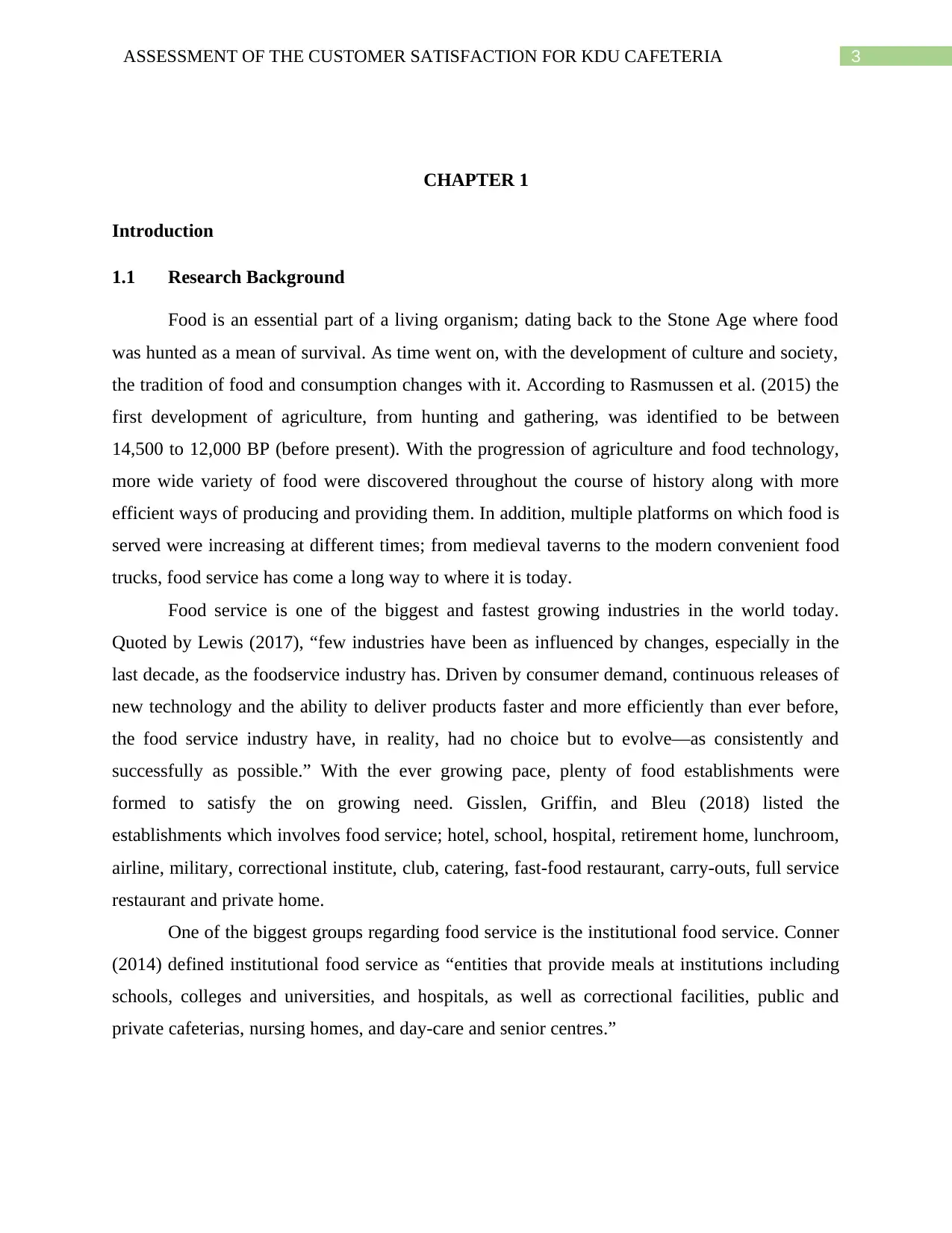
ASSESSMENT OF THE CUSTOMER SATISFACTION FOR KDU CAFETERIA 3
CHAPTER 1
Introduction
1.1 Research Background
Food is an essential part of a living organism; dating back to the Stone Age where food
was hunted as a mean of survival. As time went on, with the development of culture and society,
the tradition of food and consumption changes with it. According to Rasmussen et al. (2015) the
first development of agriculture, from hunting and gathering, was identified to be between
14,500 to 12,000 BP (before present). With the progression of agriculture and food technology,
more wide variety of food were discovered throughout the course of history along with more
efficient ways of producing and providing them. In addition, multiple platforms on which food is
served were increasing at different times; from medieval taverns to the modern convenient food
trucks, food service has come a long way to where it is today.
Food service is one of the biggest and fastest growing industries in the world today.
Quoted by Lewis (2017), “few industries have been as influenced by changes, especially in the
last decade, as the foodservice industry has. Driven by consumer demand, continuous releases of
new technology and the ability to deliver products faster and more efficiently than ever before,
the food service industry have, in reality, had no choice but to evolve—as consistently and
successfully as possible.” With the ever growing pace, plenty of food establishments were
formed to satisfy the on growing need. Gisslen, Griffin, and Bleu (2018) listed the
establishments which involves food service; hotel, school, hospital, retirement home, lunchroom,
airline, military, correctional institute, club, catering, fast-food restaurant, carry-outs, full service
restaurant and private home.
One of the biggest groups regarding food service is the institutional food service. Conner
(2014) defined institutional food service as “entities that provide meals at institutions including
schools, colleges and universities, and hospitals, as well as correctional facilities, public and
private cafeterias, nursing homes, and day-care and senior centres.”
CHAPTER 1
Introduction
1.1 Research Background
Food is an essential part of a living organism; dating back to the Stone Age where food
was hunted as a mean of survival. As time went on, with the development of culture and society,
the tradition of food and consumption changes with it. According to Rasmussen et al. (2015) the
first development of agriculture, from hunting and gathering, was identified to be between
14,500 to 12,000 BP (before present). With the progression of agriculture and food technology,
more wide variety of food were discovered throughout the course of history along with more
efficient ways of producing and providing them. In addition, multiple platforms on which food is
served were increasing at different times; from medieval taverns to the modern convenient food
trucks, food service has come a long way to where it is today.
Food service is one of the biggest and fastest growing industries in the world today.
Quoted by Lewis (2017), “few industries have been as influenced by changes, especially in the
last decade, as the foodservice industry has. Driven by consumer demand, continuous releases of
new technology and the ability to deliver products faster and more efficiently than ever before,
the food service industry have, in reality, had no choice but to evolve—as consistently and
successfully as possible.” With the ever growing pace, plenty of food establishments were
formed to satisfy the on growing need. Gisslen, Griffin, and Bleu (2018) listed the
establishments which involves food service; hotel, school, hospital, retirement home, lunchroom,
airline, military, correctional institute, club, catering, fast-food restaurant, carry-outs, full service
restaurant and private home.
One of the biggest groups regarding food service is the institutional food service. Conner
(2014) defined institutional food service as “entities that provide meals at institutions including
schools, colleges and universities, and hospitals, as well as correctional facilities, public and
private cafeterias, nursing homes, and day-care and senior centres.”
Paraphrase This Document
Need a fresh take? Get an instant paraphrase of this document with our AI Paraphraser
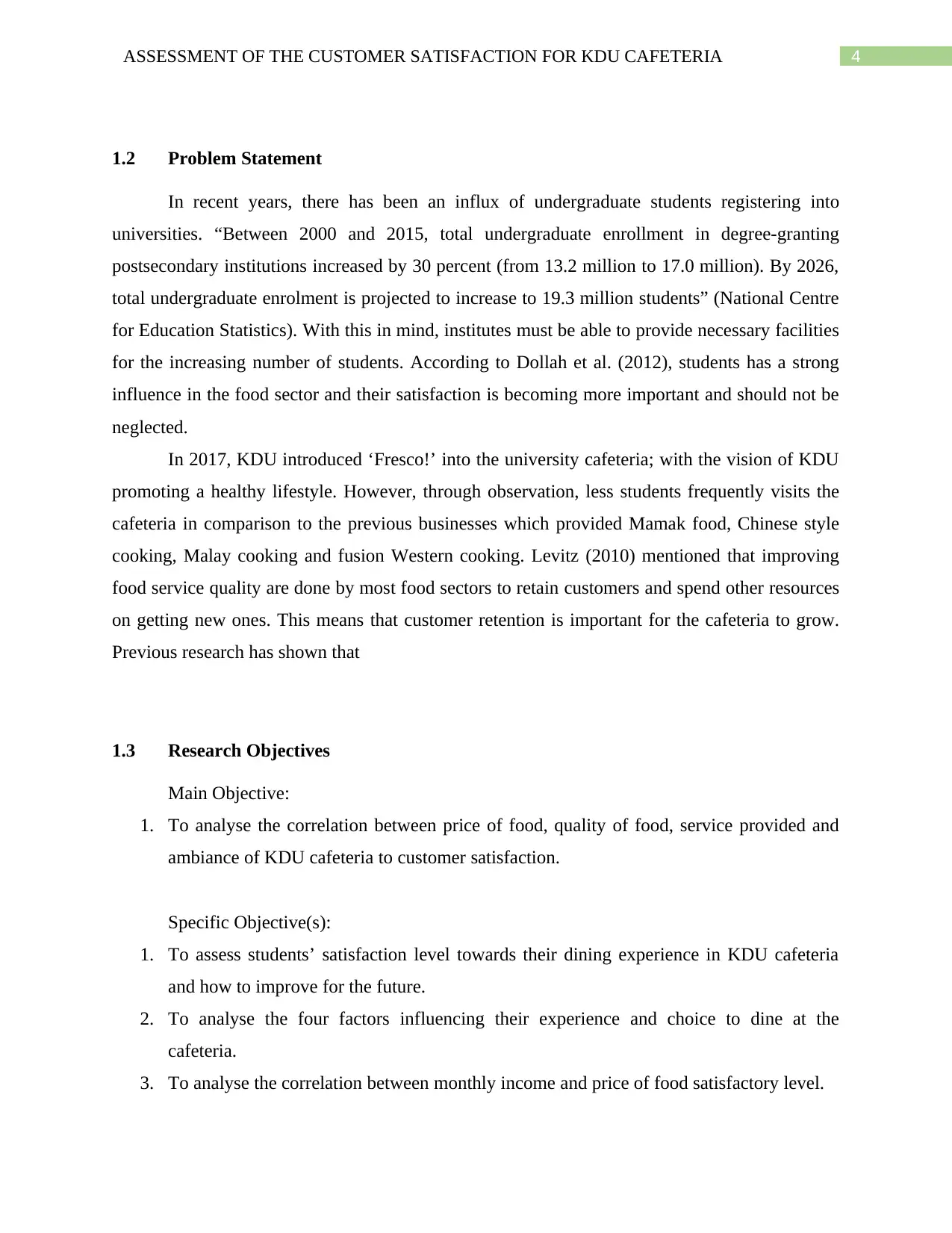
ASSESSMENT OF THE CUSTOMER SATISFACTION FOR KDU CAFETERIA 4
1.2 Problem Statement
In recent years, there has been an influx of undergraduate students registering into
universities. “Between 2000 and 2015, total undergraduate enrollment in degree-granting
postsecondary institutions increased by 30 percent (from 13.2 million to 17.0 million). By 2026,
total undergraduate enrolment is projected to increase to 19.3 million students” (National Centre
for Education Statistics). With this in mind, institutes must be able to provide necessary facilities
for the increasing number of students. According to Dollah et al. (2012), students has a strong
influence in the food sector and their satisfaction is becoming more important and should not be
neglected.
In 2017, KDU introduced ‘Fresco!’ into the university cafeteria; with the vision of KDU
promoting a healthy lifestyle. However, through observation, less students frequently visits the
cafeteria in comparison to the previous businesses which provided Mamak food, Chinese style
cooking, Malay cooking and fusion Western cooking. Levitz (2010) mentioned that improving
food service quality are done by most food sectors to retain customers and spend other resources
on getting new ones. This means that customer retention is important for the cafeteria to grow.
Previous research has shown that
1.3 Research Objectives
Main Objective:
1. To analyse the correlation between price of food, quality of food, service provided and
ambiance of KDU cafeteria to customer satisfaction.
Specific Objective(s):
1. To assess students’ satisfaction level towards their dining experience in KDU cafeteria
and how to improve for the future.
2. To analyse the four factors influencing their experience and choice to dine at the
cafeteria.
3. To analyse the correlation between monthly income and price of food satisfactory level.
1.2 Problem Statement
In recent years, there has been an influx of undergraduate students registering into
universities. “Between 2000 and 2015, total undergraduate enrollment in degree-granting
postsecondary institutions increased by 30 percent (from 13.2 million to 17.0 million). By 2026,
total undergraduate enrolment is projected to increase to 19.3 million students” (National Centre
for Education Statistics). With this in mind, institutes must be able to provide necessary facilities
for the increasing number of students. According to Dollah et al. (2012), students has a strong
influence in the food sector and their satisfaction is becoming more important and should not be
neglected.
In 2017, KDU introduced ‘Fresco!’ into the university cafeteria; with the vision of KDU
promoting a healthy lifestyle. However, through observation, less students frequently visits the
cafeteria in comparison to the previous businesses which provided Mamak food, Chinese style
cooking, Malay cooking and fusion Western cooking. Levitz (2010) mentioned that improving
food service quality are done by most food sectors to retain customers and spend other resources
on getting new ones. This means that customer retention is important for the cafeteria to grow.
Previous research has shown that
1.3 Research Objectives
Main Objective:
1. To analyse the correlation between price of food, quality of food, service provided and
ambiance of KDU cafeteria to customer satisfaction.
Specific Objective(s):
1. To assess students’ satisfaction level towards their dining experience in KDU cafeteria
and how to improve for the future.
2. To analyse the four factors influencing their experience and choice to dine at the
cafeteria.
3. To analyse the correlation between monthly income and price of food satisfactory level.
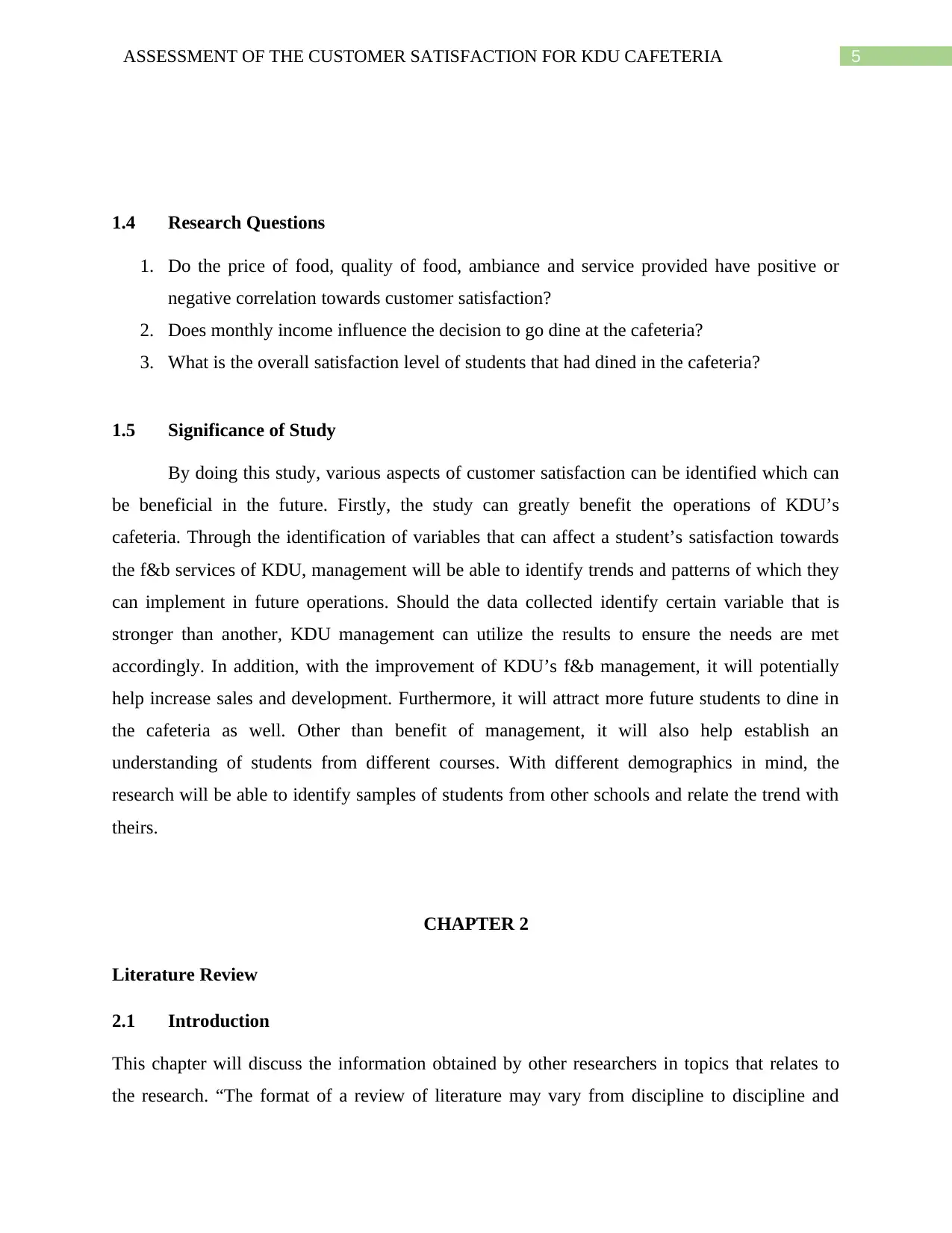
ASSESSMENT OF THE CUSTOMER SATISFACTION FOR KDU CAFETERIA 5
1.4 Research Questions
1. Do the price of food, quality of food, ambiance and service provided have positive or
negative correlation towards customer satisfaction?
2. Does monthly income influence the decision to go dine at the cafeteria?
3. What is the overall satisfaction level of students that had dined in the cafeteria?
1.5 Significance of Study
By doing this study, various aspects of customer satisfaction can be identified which can
be beneficial in the future. Firstly, the study can greatly benefit the operations of KDU’s
cafeteria. Through the identification of variables that can affect a student’s satisfaction towards
the f&b services of KDU, management will be able to identify trends and patterns of which they
can implement in future operations. Should the data collected identify certain variable that is
stronger than another, KDU management can utilize the results to ensure the needs are met
accordingly. In addition, with the improvement of KDU’s f&b management, it will potentially
help increase sales and development. Furthermore, it will attract more future students to dine in
the cafeteria as well. Other than benefit of management, it will also help establish an
understanding of students from different courses. With different demographics in mind, the
research will be able to identify samples of students from other schools and relate the trend with
theirs.
CHAPTER 2
Literature Review
2.1 Introduction
This chapter will discuss the information obtained by other researchers in topics that relates to
the research. “The format of a review of literature may vary from discipline to discipline and
1.4 Research Questions
1. Do the price of food, quality of food, ambiance and service provided have positive or
negative correlation towards customer satisfaction?
2. Does monthly income influence the decision to go dine at the cafeteria?
3. What is the overall satisfaction level of students that had dined in the cafeteria?
1.5 Significance of Study
By doing this study, various aspects of customer satisfaction can be identified which can
be beneficial in the future. Firstly, the study can greatly benefit the operations of KDU’s
cafeteria. Through the identification of variables that can affect a student’s satisfaction towards
the f&b services of KDU, management will be able to identify trends and patterns of which they
can implement in future operations. Should the data collected identify certain variable that is
stronger than another, KDU management can utilize the results to ensure the needs are met
accordingly. In addition, with the improvement of KDU’s f&b management, it will potentially
help increase sales and development. Furthermore, it will attract more future students to dine in
the cafeteria as well. Other than benefit of management, it will also help establish an
understanding of students from different courses. With different demographics in mind, the
research will be able to identify samples of students from other schools and relate the trend with
theirs.
CHAPTER 2
Literature Review
2.1 Introduction
This chapter will discuss the information obtained by other researchers in topics that relates to
the research. “The format of a review of literature may vary from discipline to discipline and
⊘ This is a preview!⊘
Do you want full access?
Subscribe today to unlock all pages.

Trusted by 1+ million students worldwide

ASSESSMENT OF THE CUSTOMER SATISFACTION FOR KDU CAFETERIA 6
from assignment to assignment. A review may be a self-contained unit an end in itself or a
preface to and rationale for engaging in primary research. A review is a required part of grant
and research proposals and often a chapter in theses and dissertations. Generally, the purpose of
a review is to analyse critically a segment of a published body of knowledge through summary,
classification, and comparison of prior research studies, reviews of literature, and theoretical
articles.” (Hall, 2018). The focus of the research is to establish the factors that influence
students’ satisfaction towards KDU university’s cafeteria. This chapter will discuss in depth past
researches, journals and articles pertaining the respected topic and find the necessary variables to
complete the research.
Nowadays, food service industry has been catering multiple sectors in institutes such as
hospitals, colleges, universities, care centres and more. Due to the growth of number of students
in public and private universities, the food service in the respected sector is expanding rapidly.
2.2 Concept & Theory
Food quality
Food is the most important aspect of the overall experience in a restaurant as accordance to Sulek
and Hensley (2014). As a result, different characteristics and aspects of food come into play such
as food quality. Knowing the importance of food quality in the restaurant business, previous
studies have examined various food quality attributes. There are some of the review of the
literature reveals that the general description of food quality among researchers emphasizes on
presentation, menu variety, healthy options, taste, freshness and temperature. Temperature is also
a sensory element of food quality (Kivela et al, 1999). According to Delwiche (2004),
temperature influence how to get the flavor of food has provided; this will be interacting with
other sensory properties such as taste, smell and sight.
Food price
Students have constrained financial resources that influence their choices of picking food service
operations, as they look for reasonable expenses. For the students, price plays a major role while
choosing a restaurant as they have restricted finances. Similarly, Nadzirah, Ab-Karim, Ghazali,
and Othman (2013) agreed that cost is the primary factor in university food service operations
since students prefer to purchase food and beverage at a cheaper price. Likewise, they indicated
that if the costs of the food and beverages are too high for students in the university or college
from assignment to assignment. A review may be a self-contained unit an end in itself or a
preface to and rationale for engaging in primary research. A review is a required part of grant
and research proposals and often a chapter in theses and dissertations. Generally, the purpose of
a review is to analyse critically a segment of a published body of knowledge through summary,
classification, and comparison of prior research studies, reviews of literature, and theoretical
articles.” (Hall, 2018). The focus of the research is to establish the factors that influence
students’ satisfaction towards KDU university’s cafeteria. This chapter will discuss in depth past
researches, journals and articles pertaining the respected topic and find the necessary variables to
complete the research.
Nowadays, food service industry has been catering multiple sectors in institutes such as
hospitals, colleges, universities, care centres and more. Due to the growth of number of students
in public and private universities, the food service in the respected sector is expanding rapidly.
2.2 Concept & Theory
Food quality
Food is the most important aspect of the overall experience in a restaurant as accordance to Sulek
and Hensley (2014). As a result, different characteristics and aspects of food come into play such
as food quality. Knowing the importance of food quality in the restaurant business, previous
studies have examined various food quality attributes. There are some of the review of the
literature reveals that the general description of food quality among researchers emphasizes on
presentation, menu variety, healthy options, taste, freshness and temperature. Temperature is also
a sensory element of food quality (Kivela et al, 1999). According to Delwiche (2004),
temperature influence how to get the flavor of food has provided; this will be interacting with
other sensory properties such as taste, smell and sight.
Food price
Students have constrained financial resources that influence their choices of picking food service
operations, as they look for reasonable expenses. For the students, price plays a major role while
choosing a restaurant as they have restricted finances. Similarly, Nadzirah, Ab-Karim, Ghazali,
and Othman (2013) agreed that cost is the primary factor in university food service operations
since students prefer to purchase food and beverage at a cheaper price. Likewise, they indicated
that if the costs of the food and beverages are too high for students in the university or college
Paraphrase This Document
Need a fresh take? Get an instant paraphrase of this document with our AI Paraphraser
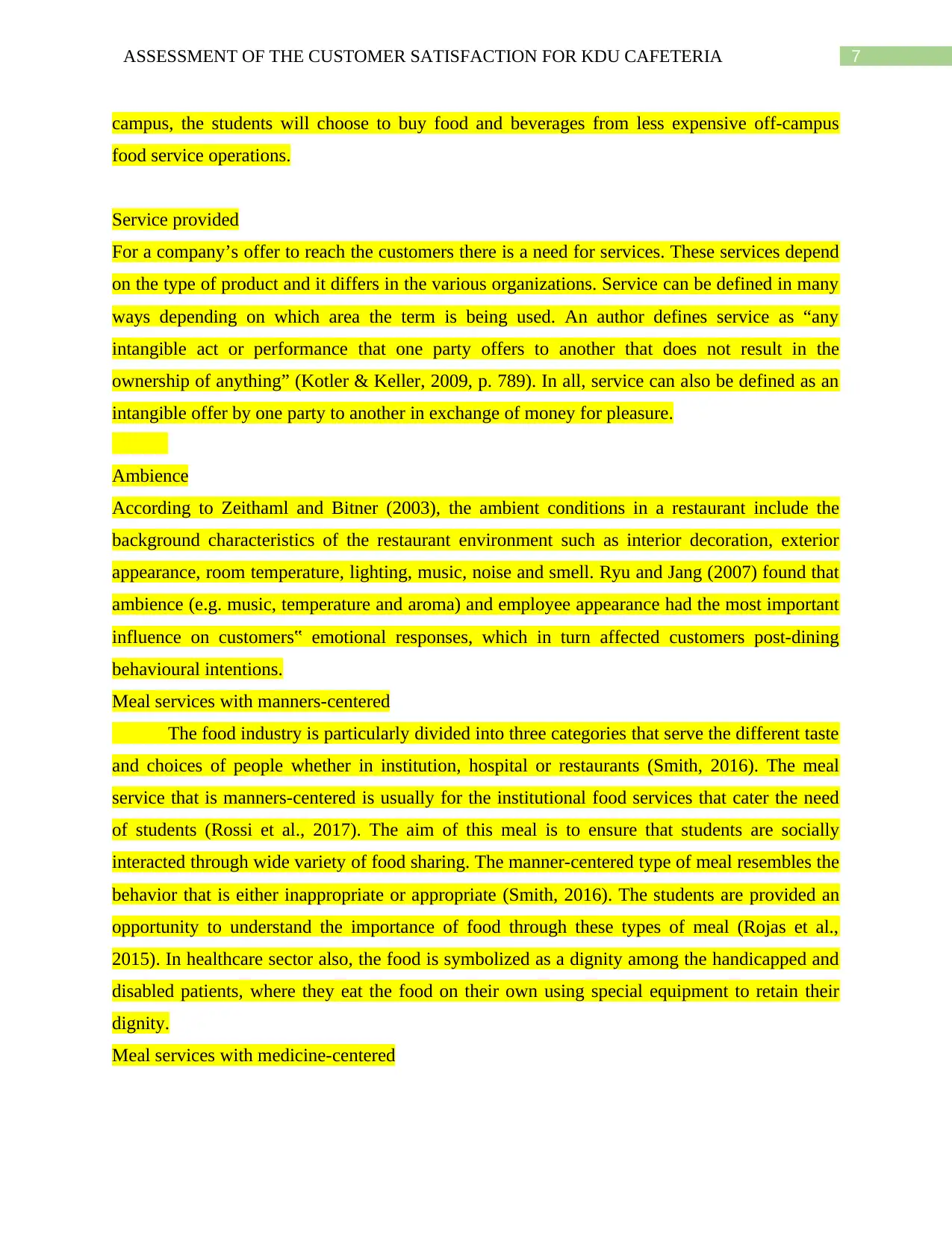
ASSESSMENT OF THE CUSTOMER SATISFACTION FOR KDU CAFETERIA 7
campus, the students will choose to buy food and beverages from less expensive off-campus
food service operations.
Service provided
For a company’s offer to reach the customers there is a need for services. These services depend
on the type of product and it differs in the various organizations. Service can be defined in many
ways depending on which area the term is being used. An author defines service as “any
intangible act or performance that one party offers to another that does not result in the
ownership of anything” (Kotler & Keller, 2009, p. 789). In all, service can also be defined as an
intangible offer by one party to another in exchange of money for pleasure.
Ambience
According to Zeithaml and Bitner (2003), the ambient conditions in a restaurant include the
background characteristics of the restaurant environment such as interior decoration, exterior
appearance, room temperature, lighting, music, noise and smell. Ryu and Jang (2007) found that
ambience (e.g. music, temperature and aroma) and employee appearance had the most important
influence on customers‟ emotional responses, which in turn affected customers post-dining
behavioural intentions.
Meal services with manners-centered
The food industry is particularly divided into three categories that serve the different taste
and choices of people whether in institution, hospital or restaurants (Smith, 2016). The meal
service that is manners-centered is usually for the institutional food services that cater the need
of students (Rossi et al., 2017). The aim of this meal is to ensure that students are socially
interacted through wide variety of food sharing. The manner-centered type of meal resembles the
behavior that is either inappropriate or appropriate (Smith, 2016). The students are provided an
opportunity to understand the importance of food through these types of meal (Rojas et al.,
2015). In healthcare sector also, the food is symbolized as a dignity among the handicapped and
disabled patients, where they eat the food on their own using special equipment to retain their
dignity.
Meal services with medicine-centered
campus, the students will choose to buy food and beverages from less expensive off-campus
food service operations.
Service provided
For a company’s offer to reach the customers there is a need for services. These services depend
on the type of product and it differs in the various organizations. Service can be defined in many
ways depending on which area the term is being used. An author defines service as “any
intangible act or performance that one party offers to another that does not result in the
ownership of anything” (Kotler & Keller, 2009, p. 789). In all, service can also be defined as an
intangible offer by one party to another in exchange of money for pleasure.
Ambience
According to Zeithaml and Bitner (2003), the ambient conditions in a restaurant include the
background characteristics of the restaurant environment such as interior decoration, exterior
appearance, room temperature, lighting, music, noise and smell. Ryu and Jang (2007) found that
ambience (e.g. music, temperature and aroma) and employee appearance had the most important
influence on customers‟ emotional responses, which in turn affected customers post-dining
behavioural intentions.
Meal services with manners-centered
The food industry is particularly divided into three categories that serve the different taste
and choices of people whether in institution, hospital or restaurants (Smith, 2016). The meal
service that is manners-centered is usually for the institutional food services that cater the need
of students (Rossi et al., 2017). The aim of this meal is to ensure that students are socially
interacted through wide variety of food sharing. The manner-centered type of meal resembles the
behavior that is either inappropriate or appropriate (Smith, 2016). The students are provided an
opportunity to understand the importance of food through these types of meal (Rojas et al.,
2015). In healthcare sector also, the food is symbolized as a dignity among the handicapped and
disabled patients, where they eat the food on their own using special equipment to retain their
dignity.
Meal services with medicine-centered
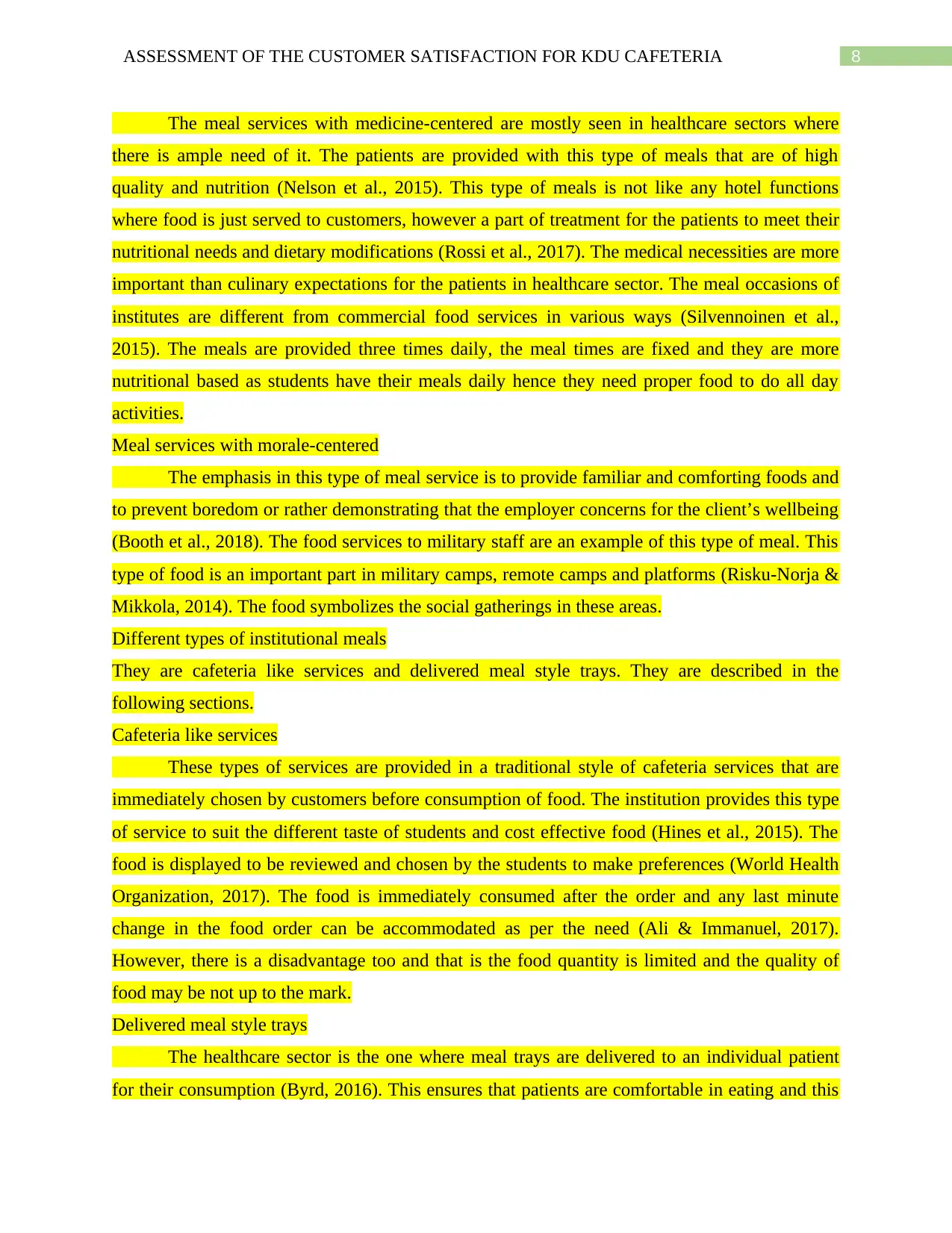
ASSESSMENT OF THE CUSTOMER SATISFACTION FOR KDU CAFETERIA 8
The meal services with medicine-centered are mostly seen in healthcare sectors where
there is ample need of it. The patients are provided with this type of meals that are of high
quality and nutrition (Nelson et al., 2015). This type of meals is not like any hotel functions
where food is just served to customers, however a part of treatment for the patients to meet their
nutritional needs and dietary modifications (Rossi et al., 2017). The medical necessities are more
important than culinary expectations for the patients in healthcare sector. The meal occasions of
institutes are different from commercial food services in various ways (Silvennoinen et al.,
2015). The meals are provided three times daily, the meal times are fixed and they are more
nutritional based as students have their meals daily hence they need proper food to do all day
activities.
Meal services with morale-centered
The emphasis in this type of meal service is to provide familiar and comforting foods and
to prevent boredom or rather demonstrating that the employer concerns for the client’s wellbeing
(Booth et al., 2018). The food services to military staff are an example of this type of meal. This
type of food is an important part in military camps, remote camps and platforms (Risku-Norja &
Mikkola, 2014). The food symbolizes the social gatherings in these areas.
Different types of institutional meals
They are cafeteria like services and delivered meal style trays. They are described in the
following sections.
Cafeteria like services
These types of services are provided in a traditional style of cafeteria services that are
immediately chosen by customers before consumption of food. The institution provides this type
of service to suit the different taste of students and cost effective food (Hines et al., 2015). The
food is displayed to be reviewed and chosen by the students to make preferences (World Health
Organization, 2017). The food is immediately consumed after the order and any last minute
change in the food order can be accommodated as per the need (Ali & Immanuel, 2017).
However, there is a disadvantage too and that is the food quantity is limited and the quality of
food may be not up to the mark.
Delivered meal style trays
The healthcare sector is the one where meal trays are delivered to an individual patient
for their consumption (Byrd, 2016). This ensures that patients are comfortable in eating and this
The meal services with medicine-centered are mostly seen in healthcare sectors where
there is ample need of it. The patients are provided with this type of meals that are of high
quality and nutrition (Nelson et al., 2015). This type of meals is not like any hotel functions
where food is just served to customers, however a part of treatment for the patients to meet their
nutritional needs and dietary modifications (Rossi et al., 2017). The medical necessities are more
important than culinary expectations for the patients in healthcare sector. The meal occasions of
institutes are different from commercial food services in various ways (Silvennoinen et al.,
2015). The meals are provided three times daily, the meal times are fixed and they are more
nutritional based as students have their meals daily hence they need proper food to do all day
activities.
Meal services with morale-centered
The emphasis in this type of meal service is to provide familiar and comforting foods and
to prevent boredom or rather demonstrating that the employer concerns for the client’s wellbeing
(Booth et al., 2018). The food services to military staff are an example of this type of meal. This
type of food is an important part in military camps, remote camps and platforms (Risku-Norja &
Mikkola, 2014). The food symbolizes the social gatherings in these areas.
Different types of institutional meals
They are cafeteria like services and delivered meal style trays. They are described in the
following sections.
Cafeteria like services
These types of services are provided in a traditional style of cafeteria services that are
immediately chosen by customers before consumption of food. The institution provides this type
of service to suit the different taste of students and cost effective food (Hines et al., 2015). The
food is displayed to be reviewed and chosen by the students to make preferences (World Health
Organization, 2017). The food is immediately consumed after the order and any last minute
change in the food order can be accommodated as per the need (Ali & Immanuel, 2017).
However, there is a disadvantage too and that is the food quantity is limited and the quality of
food may be not up to the mark.
Delivered meal style trays
The healthcare sector is the one where meal trays are delivered to an individual patient
for their consumption (Byrd, 2016). This ensures that patients are comfortable in eating and this
⊘ This is a preview!⊘
Do you want full access?
Subscribe today to unlock all pages.

Trusted by 1+ million students worldwide
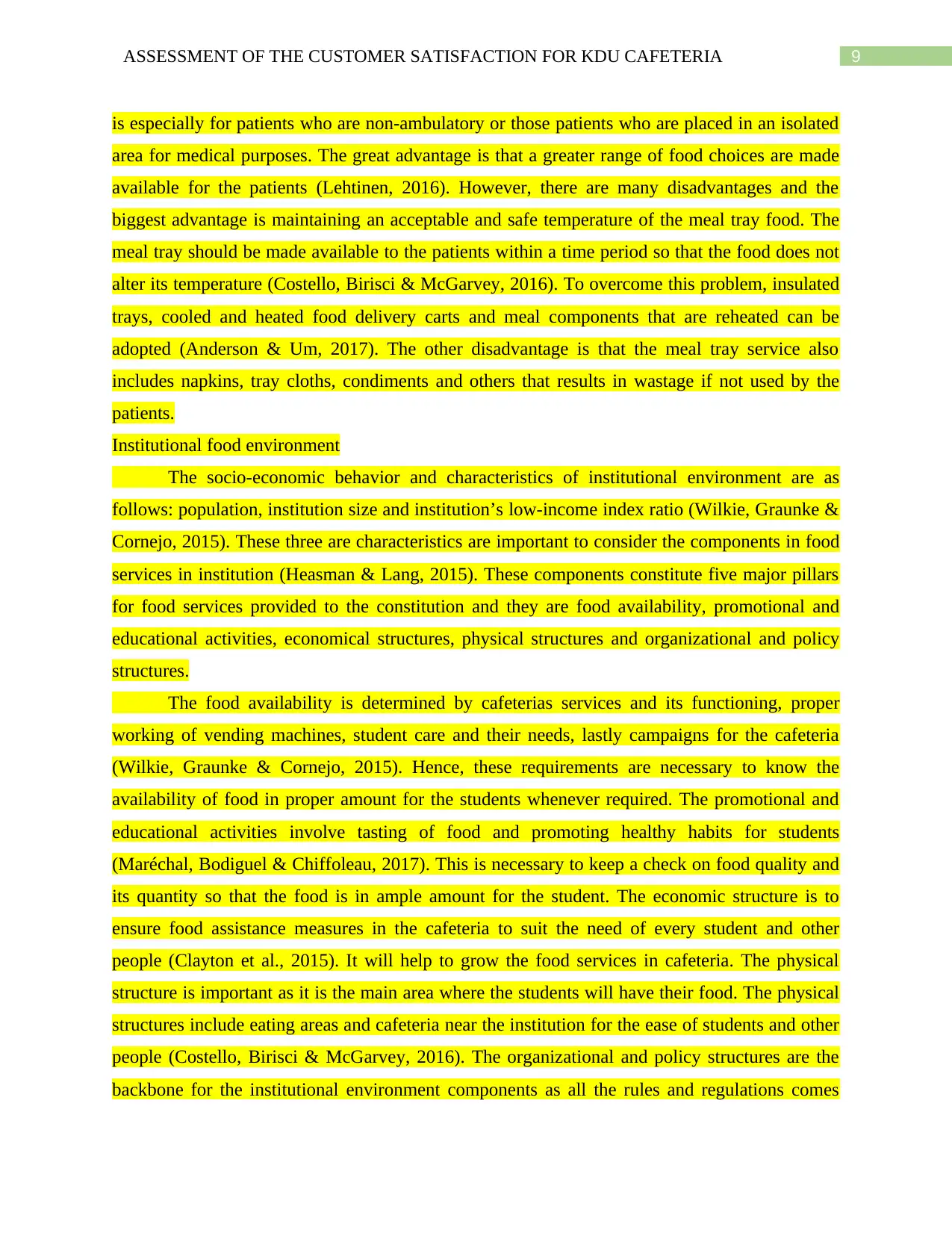
ASSESSMENT OF THE CUSTOMER SATISFACTION FOR KDU CAFETERIA 9
is especially for patients who are non-ambulatory or those patients who are placed in an isolated
area for medical purposes. The great advantage is that a greater range of food choices are made
available for the patients (Lehtinen, 2016). However, there are many disadvantages and the
biggest advantage is maintaining an acceptable and safe temperature of the meal tray food. The
meal tray should be made available to the patients within a time period so that the food does not
alter its temperature (Costello, Birisci & McGarvey, 2016). To overcome this problem, insulated
trays, cooled and heated food delivery carts and meal components that are reheated can be
adopted (Anderson & Um, 2017). The other disadvantage is that the meal tray service also
includes napkins, tray cloths, condiments and others that results in wastage if not used by the
patients.
Institutional food environment
The socio-economic behavior and characteristics of institutional environment are as
follows: population, institution size and institution’s low-income index ratio (Wilkie, Graunke &
Cornejo, 2015). These three are characteristics are important to consider the components in food
services in institution (Heasman & Lang, 2015). These components constitute five major pillars
for food services provided to the constitution and they are food availability, promotional and
educational activities, economical structures, physical structures and organizational and policy
structures.
The food availability is determined by cafeterias services and its functioning, proper
working of vending machines, student care and their needs, lastly campaigns for the cafeteria
(Wilkie, Graunke & Cornejo, 2015). Hence, these requirements are necessary to know the
availability of food in proper amount for the students whenever required. The promotional and
educational activities involve tasting of food and promoting healthy habits for students
(Maréchal, Bodiguel & Chiffoleau, 2017). This is necessary to keep a check on food quality and
its quantity so that the food is in ample amount for the student. The economic structure is to
ensure food assistance measures in the cafeteria to suit the need of every student and other
people (Clayton et al., 2015). It will help to grow the food services in cafeteria. The physical
structure is important as it is the main area where the students will have their food. The physical
structures include eating areas and cafeteria near the institution for the ease of students and other
people (Costello, Birisci & McGarvey, 2016). The organizational and policy structures are the
backbone for the institutional environment components as all the rules and regulations comes
is especially for patients who are non-ambulatory or those patients who are placed in an isolated
area for medical purposes. The great advantage is that a greater range of food choices are made
available for the patients (Lehtinen, 2016). However, there are many disadvantages and the
biggest advantage is maintaining an acceptable and safe temperature of the meal tray food. The
meal tray should be made available to the patients within a time period so that the food does not
alter its temperature (Costello, Birisci & McGarvey, 2016). To overcome this problem, insulated
trays, cooled and heated food delivery carts and meal components that are reheated can be
adopted (Anderson & Um, 2017). The other disadvantage is that the meal tray service also
includes napkins, tray cloths, condiments and others that results in wastage if not used by the
patients.
Institutional food environment
The socio-economic behavior and characteristics of institutional environment are as
follows: population, institution size and institution’s low-income index ratio (Wilkie, Graunke &
Cornejo, 2015). These three are characteristics are important to consider the components in food
services in institution (Heasman & Lang, 2015). These components constitute five major pillars
for food services provided to the constitution and they are food availability, promotional and
educational activities, economical structures, physical structures and organizational and policy
structures.
The food availability is determined by cafeterias services and its functioning, proper
working of vending machines, student care and their needs, lastly campaigns for the cafeteria
(Wilkie, Graunke & Cornejo, 2015). Hence, these requirements are necessary to know the
availability of food in proper amount for the students whenever required. The promotional and
educational activities involve tasting of food and promoting healthy habits for students
(Maréchal, Bodiguel & Chiffoleau, 2017). This is necessary to keep a check on food quality and
its quantity so that the food is in ample amount for the student. The economic structure is to
ensure food assistance measures in the cafeteria to suit the need of every student and other
people (Clayton et al., 2015). It will help to grow the food services in cafeteria. The physical
structure is important as it is the main area where the students will have their food. The physical
structures include eating areas and cafeteria near the institution for the ease of students and other
people (Costello, Birisci & McGarvey, 2016). The organizational and policy structures are the
backbone for the institutional environment components as all the rules and regulations comes
Paraphrase This Document
Need a fresh take? Get an instant paraphrase of this document with our AI Paraphraser
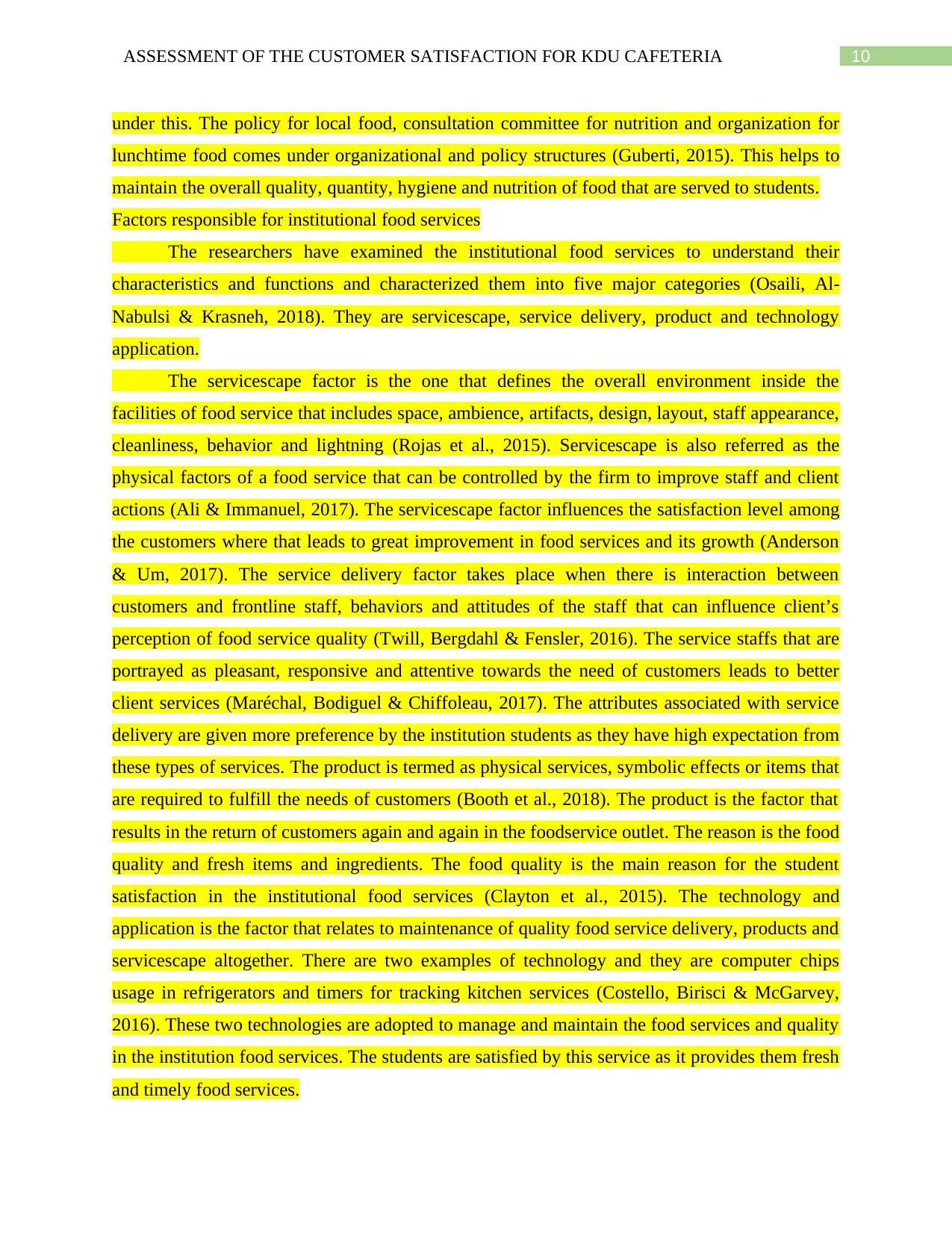
ASSESSMENT OF THE CUSTOMER SATISFACTION FOR KDU CAFETERIA 10
under this. The policy for local food, consultation committee for nutrition and organization for
lunchtime food comes under organizational and policy structures (Guberti, 2015). This helps to
maintain the overall quality, quantity, hygiene and nutrition of food that are served to students.
Factors responsible for institutional food services
The researchers have examined the institutional food services to understand their
characteristics and functions and characterized them into five major categories (Osaili, Al-
Nabulsi & Krasneh, 2018). They are servicescape, service delivery, product and technology
application.
The servicescape factor is the one that defines the overall environment inside the
facilities of food service that includes space, ambience, artifacts, design, layout, staff appearance,
cleanliness, behavior and lightning (Rojas et al., 2015). Servicescape is also referred as the
physical factors of a food service that can be controlled by the firm to improve staff and client
actions (Ali & Immanuel, 2017). The servicescape factor influences the satisfaction level among
the customers where that leads to great improvement in food services and its growth (Anderson
& Um, 2017). The service delivery factor takes place when there is interaction between
customers and frontline staff, behaviors and attitudes of the staff that can influence client’s
perception of food service quality (Twill, Bergdahl & Fensler, 2016). The service staffs that are
portrayed as pleasant, responsive and attentive towards the need of customers leads to better
client services (Maréchal, Bodiguel & Chiffoleau, 2017). The attributes associated with service
delivery are given more preference by the institution students as they have high expectation from
these types of services. The product is termed as physical services, symbolic effects or items that
are required to fulfill the needs of customers (Booth et al., 2018). The product is the factor that
results in the return of customers again and again in the foodservice outlet. The reason is the food
quality and fresh items and ingredients. The food quality is the main reason for the student
satisfaction in the institutional food services (Clayton et al., 2015). The technology and
application is the factor that relates to maintenance of quality food service delivery, products and
servicescape altogether. There are two examples of technology and they are computer chips
usage in refrigerators and timers for tracking kitchen services (Costello, Birisci & McGarvey,
2016). These two technologies are adopted to manage and maintain the food services and quality
in the institution food services. The students are satisfied by this service as it provides them fresh
and timely food services.
under this. The policy for local food, consultation committee for nutrition and organization for
lunchtime food comes under organizational and policy structures (Guberti, 2015). This helps to
maintain the overall quality, quantity, hygiene and nutrition of food that are served to students.
Factors responsible for institutional food services
The researchers have examined the institutional food services to understand their
characteristics and functions and characterized them into five major categories (Osaili, Al-
Nabulsi & Krasneh, 2018). They are servicescape, service delivery, product and technology
application.
The servicescape factor is the one that defines the overall environment inside the
facilities of food service that includes space, ambience, artifacts, design, layout, staff appearance,
cleanliness, behavior and lightning (Rojas et al., 2015). Servicescape is also referred as the
physical factors of a food service that can be controlled by the firm to improve staff and client
actions (Ali & Immanuel, 2017). The servicescape factor influences the satisfaction level among
the customers where that leads to great improvement in food services and its growth (Anderson
& Um, 2017). The service delivery factor takes place when there is interaction between
customers and frontline staff, behaviors and attitudes of the staff that can influence client’s
perception of food service quality (Twill, Bergdahl & Fensler, 2016). The service staffs that are
portrayed as pleasant, responsive and attentive towards the need of customers leads to better
client services (Maréchal, Bodiguel & Chiffoleau, 2017). The attributes associated with service
delivery are given more preference by the institution students as they have high expectation from
these types of services. The product is termed as physical services, symbolic effects or items that
are required to fulfill the needs of customers (Booth et al., 2018). The product is the factor that
results in the return of customers again and again in the foodservice outlet. The reason is the food
quality and fresh items and ingredients. The food quality is the main reason for the student
satisfaction in the institutional food services (Clayton et al., 2015). The technology and
application is the factor that relates to maintenance of quality food service delivery, products and
servicescape altogether. There are two examples of technology and they are computer chips
usage in refrigerators and timers for tracking kitchen services (Costello, Birisci & McGarvey,
2016). These two technologies are adopted to manage and maintain the food services and quality
in the institution food services. The students are satisfied by this service as it provides them fresh
and timely food services.
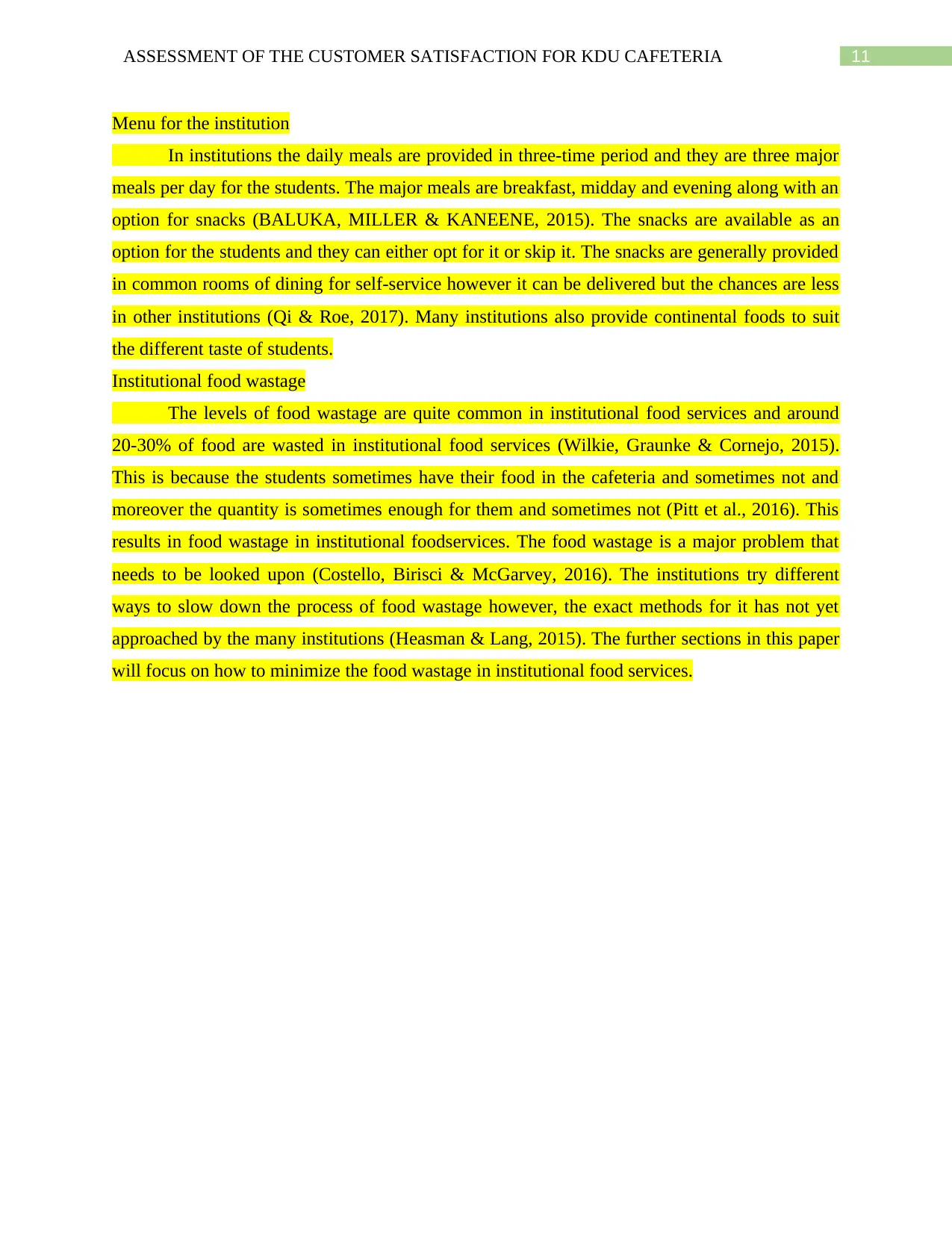
ASSESSMENT OF THE CUSTOMER SATISFACTION FOR KDU CAFETERIA 11
Menu for the institution
In institutions the daily meals are provided in three-time period and they are three major
meals per day for the students. The major meals are breakfast, midday and evening along with an
option for snacks (BALUKA, MILLER & KANEENE, 2015). The snacks are available as an
option for the students and they can either opt for it or skip it. The snacks are generally provided
in common rooms of dining for self-service however it can be delivered but the chances are less
in other institutions (Qi & Roe, 2017). Many institutions also provide continental foods to suit
the different taste of students.
Institutional food wastage
The levels of food wastage are quite common in institutional food services and around
20-30% of food are wasted in institutional food services (Wilkie, Graunke & Cornejo, 2015).
This is because the students sometimes have their food in the cafeteria and sometimes not and
moreover the quantity is sometimes enough for them and sometimes not (Pitt et al., 2016). This
results in food wastage in institutional foodservices. The food wastage is a major problem that
needs to be looked upon (Costello, Birisci & McGarvey, 2016). The institutions try different
ways to slow down the process of food wastage however, the exact methods for it has not yet
approached by the many institutions (Heasman & Lang, 2015). The further sections in this paper
will focus on how to minimize the food wastage in institutional food services.
Menu for the institution
In institutions the daily meals are provided in three-time period and they are three major
meals per day for the students. The major meals are breakfast, midday and evening along with an
option for snacks (BALUKA, MILLER & KANEENE, 2015). The snacks are available as an
option for the students and they can either opt for it or skip it. The snacks are generally provided
in common rooms of dining for self-service however it can be delivered but the chances are less
in other institutions (Qi & Roe, 2017). Many institutions also provide continental foods to suit
the different taste of students.
Institutional food wastage
The levels of food wastage are quite common in institutional food services and around
20-30% of food are wasted in institutional food services (Wilkie, Graunke & Cornejo, 2015).
This is because the students sometimes have their food in the cafeteria and sometimes not and
moreover the quantity is sometimes enough for them and sometimes not (Pitt et al., 2016). This
results in food wastage in institutional foodservices. The food wastage is a major problem that
needs to be looked upon (Costello, Birisci & McGarvey, 2016). The institutions try different
ways to slow down the process of food wastage however, the exact methods for it has not yet
approached by the many institutions (Heasman & Lang, 2015). The further sections in this paper
will focus on how to minimize the food wastage in institutional food services.
⊘ This is a preview!⊘
Do you want full access?
Subscribe today to unlock all pages.

Trusted by 1+ million students worldwide
1 out of 47
Related Documents
Your All-in-One AI-Powered Toolkit for Academic Success.
+13062052269
info@desklib.com
Available 24*7 on WhatsApp / Email
![[object Object]](/_next/static/media/star-bottom.7253800d.svg)
Unlock your academic potential
Copyright © 2020–2025 A2Z Services. All Rights Reserved. Developed and managed by ZUCOL.





